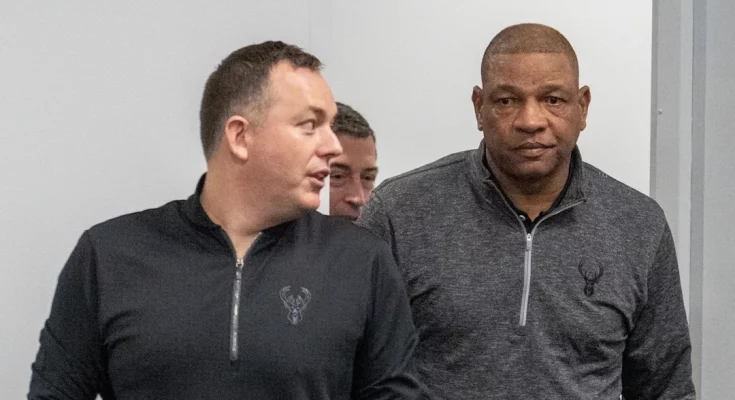The NBA offseason has been nothing short of chaotic, with franchise-altering trades, shocking free-agent decisions, and superstar movement dominating the headlines. But sometimes, it’s not the blockbuster moves that reveal the most about a team’s direction—it’s the smaller details, the underrated names, and the overlooked contributors that tell the deeper story. In Milwaukee, that’s where the case of AJ Green begins to matter. With Damian Lillard now out of the picture and the Bucks facing a crossroads between contending and retooling, voices are rising about how much more responsibility will fall on the shoulders of the team’s supporting cast. Among them, AJ Green’s name has emerged as a focal point, not just within Milwaukee’s roster development but also in broader NBA discussions around respect, opportunity, and recognition.
Green, a 6-foot-4 guard who signed a two-year deal worth \$6.3 million, isn’t a household name. He doesn’t get featured on ESPN highlight reels or trend on social media after dropping 30 points in a primetime game. He’s not the flashiest player on the floor, nor does he carry the resume of a former lottery pick. But what he does possess is something that every successful NBA roster needs—efficiency, intelligence, and quiet resilience. And as Bleacher Report’s Dan Favale pointed out, the league hasn’t exactly shown him the respect he arguably deserves. Favale cited Green as one of the most underappreciated players on a minimum-type contract, a label that speaks more about the league’s perception of him than his actual value on the court.
This idea of being “disrespected” is a charged one in professional sports. For some, it’s a buzzword, a manufactured chip on the shoulder used to ignite motivation. But for others, it reflects a broader systemic issue—where certain players, often those who aren’t flashy or don’t come from blue-blood programs, struggle to earn the same recognition and trust as their more pedigreed counterparts. In Green’s case, his shooting percentages and impact metrics suggest he could—and perhaps should—have a bigger role than he’s been given thus far.
Last season, AJ Green shot over 40% from three-point range, showing himself to be a reliable floor-spacer—something that’s become a currency in today’s NBA. While he didn’t get heavy minutes, when he was on the floor, Green delivered. He moved without the ball. He made smart decisions. He didn’t try to do too much. He played his role. That kind of dependability is something every coach values, but not every team showcases. With the departure of Damian Lillard, Milwaukee may have no choice but to lean more heavily on players like Green—not just in garbage time or during the dog days of the season, but in meaningful moments, when spacing, discipline, and trust are at a premium.
The Bucks’ rotation now faces serious questions. Giannis Antetokounmpo remains the franchise cornerstone, but the team’s identity is shifting rapidly. Khris Middleton’s injuries have made him unreliable as a consistent secondary option, and the frontcourt depth is being tested more than ever before. Milwaukee’s hopes now partially hinge on how well players like Green can rise to the occasion and make the most of their increased responsibilities. He might not be the face of the franchise, but his development could impact the outcome of close games, playoff positioning, and the overall balance of power in the Eastern Conference.
More importantly, Green’s path also speaks to a broader truth about development and opportunity in the NBA. The league is full of talent—more than ever before. With international scouting expanding, G League development improving, and college basketball continuing to churn out capable pros, the margins have shrunk. Every team has access to good players. The question becomes: who gets the chance? And who gets trusted with the ball in their hands during crucial possessions?
AJ Green has already shown he has one elite skill—shooting. And in the modern NBA, being able to shoot at a high clip from deep is often the difference between riding the bench and staying in a rotation. But the fact that he hasn’t cracked the starting lineup or carved out a defined sixth-man role on a team that desperately needed offensive consistency says more about the structure of coaching decisions and trust in veteran rotations than it does about his ability. He’s been labeled a specialist. That can be both a compliment and a limiting designation. Specialists often get pigeonholed. They’re brought in for spot minutes. They’re overlooked for full-time responsibility. That label of “specialist” can become a box—hard to get out of once it’s taped shut.
Favale’s commentary touches on this very point. By calling out Green’s undervaluation, he’s not just advocating for Green personally; he’s highlighting a flaw in how teams and analysts evaluate role players. Green’s deal, worth \$6.3 million over two years, is a bargain in the context of the league’s current financial climate. It’s the kind of deal that, if he breaks out, will look like a steal. But it also reflects the limited leverage players like him have in a marketplace that values upside, fame, and flash more than it does consistent, unspectacular production.
The coming season represents a tipping point, both for Green and for the Bucks. Under new head coach Doc Rivers, Milwaukee is trying to navigate a challenging path—keeping their championship window open while also acknowledging that some of their older stars are past their physical peaks. Green fits into this new vision not because he’s flashy, but because he’s efficient. Because he’s low-maintenance. Because he understands his role, and executes it well. But now, he may be asked to do more than just “understand his role.” He might be asked to redefine it entirely.
There’s precedent for this kind of leap. Players like Duncan Robinson, Max Strus, and Gary Payton II have all gone from the fringes of NBA rosters to essential contributors on playoff teams—often with similar stories of being undervalued, underappreciated, and ultimately proving their worth. Green could follow that blueprint. If Milwaukee’s spacing issues persist, if their second unit lacks scoring punch, or if injuries force Rivers to shuffle his lineups, Green could find himself with more minutes, more shots, and more visibility than ever before.
The question then becomes: will he seize it? And perhaps even more crucially, will the Bucks give him a long enough leash to find his rhythm?
At 24 years old, Green is still early in his career. He has time to evolve. But the window for proving yourself in the NBA can be narrow—especially for undrafted or second-round players. Every minute matters. Every shot is scrutinized. There is pressure that comes with being a bench player asked to step up—especially when the narrative surrounding you includes phrases like “disrespected.” That word brings its own expectations. It implies you have something to prove. And if you don’t prove it quickly, the league moves on.
Milwaukee, for its part, seems to understand that it needs internal development more than ever. With few tradable assets and a tight salary cap situation, the Bucks won’t have the flexibility to chase stars or even high-end veterans on the open market. Their improvement must come from within—from Giannis sharpening his playmaking, from Middleton staying healthy, from Brook Lopez continuing to defy age—and yes, from role players like AJ Green taking leaps that nobody saw coming.
There’s a strange beauty to stories like Green’s. They remind us that the NBA isn’t just about superstars. It’s about the 8th man in the rotation who comes in and hits back-to-back threes in a playoff game. It’s about the guy who spends more time in the film room than in interviews. It’s about the ones who wait their turn, fight for every possession, and turn “disrespected” into “indispensable.”
For the Bucks, the 2025 season won’t be defined by splashy headlines. It will be defined by chemistry, by cohesion, and by the ability of players like AJ Green to rise above the expectations placed on them by pundits, coaches, and sometimes even their own front office. Green won’t change Milwaukee’s fate overnight. But he could be the difference between stagnation and surprise. Between a disappointing early exit and an unexpected playoff run. Between irrelevance and redemption.
The NBA doesn’t always reward the quiet contributors. But when it does, it’s because someone finally noticed what they bring to the table—every day, every practice, every off-ball cut and catch-and-shoot three. This season might just be AJ Green’s moment to be noticed. Not as a minimum-contract shooter. Not as a bench piece. But as someone who demands respect not with words, but with action. The league may not have given it to him yet—but now, the spotlight might not give him a choice.
The NBA offseason has been nothing short of chaotic, with franchise-altering trades, shocking free-agent decisions, and superstar movement dominating the headlines. But sometimes, it’s not the blockbuster moves that reveal the most about a team’s direction—it’s the smaller details, the underrated names, and the overlooked contributors that tell the deeper story. In Milwaukee, that’s where the case of AJ Green begins to matter. With Damian Lillard now out of the picture and the Bucks facing a crossroads between contending and retooling, voices are rising about how much more responsibility will fall on the shoulders of the team’s supporting cast. Among them, AJ Green’s name has emerged as a focal point, not just within Milwaukee’s roster development but also in broader NBA discussions around respect, opportunity, and recognition.
Green, a 6-foot-4 guard who signed a two-year deal worth \$6.3 million, isn’t a household name. He doesn’t get featured on ESPN highlight reels or trend on social media after dropping 30 points in a primetime game. He’s not the flashiest player on the floor, nor does he carry the resume of a former lottery pick. But what he does possess is something that every successful NBA roster needs—efficiency, intelligence, and quiet resilience. And as Bleacher Report’s Dan Favale pointed out, the league hasn’t exactly shown him the respect he arguably deserves. Favale cited Green as one of the most underappreciated players on a minimum-type contract, a label that speaks more about the league’s perception of him than his actual value on the court.
This idea of being “disrespected” is a charged one in professional sports. For some, it’s a buzzword, a manufactured chip on the shoulder used to ignite motivation. But for others, it reflects a broader systemic issue—where certain players, often those who aren’t flashy or don’t come from blue-blood programs, struggle to earn the same recognition and trust as their more pedigreed counterparts. In Green’s case, his shooting percentages and impact metrics suggest he could—and perhaps should—have a bigger role than he’s been given thus far.
Last season, AJ Green shot over 40% from three-point range, showing himself to be a reliable floor-spacer—something that’s become a currency in today’s NBA. While he didn’t get heavy minutes, when he was on the floor, Green delivered. He moved without the ball. He made smart decisions. He didn’t try to do too much. He played his role. That kind of dependability is something every coach values, but not every team showcases. With the departure of Damian Lillard, Milwaukee may have no choice but to lean more heavily on players like Green—not just in garbage time or during the dog days of the season, but in meaningful moments, when spacing, discipline, and trust are at a premium.
The Bucks’ rotation now faces serious questions. Giannis Antetokounmpo remains the franchise cornerstone, but the team’s identity is shifting rapidly. Khris Middleton’s injuries have made him unreliable as a consistent secondary option, and the frontcourt depth is being tested more than ever before. Milwaukee’s hopes now partially hinge on how well players like Green can rise to the occasion and make the most of their increased responsibilities. He might not be the face of the franchise, but his development could impact the outcome of close games, playoff positioning, and the overall balance of power in the Eastern Conference.
More importantly, Green’s path also speaks to a broader truth about development and opportunity in the NBA. The league is full of talent—more than ever before. With international scouting expanding, G League development improving, and college basketball continuing to churn out capable pros, the margins have shrunk. Every team has access to good players. The question becomes: who gets the chance? And who gets trusted with the ball in their hands during crucial possessions?
AJ Green has already shown he has one elite skill—shooting. And in the modern NBA, being able to shoot at a high clip from deep is often the difference between riding the bench and staying in a rotation. But the fact that he hasn’t cracked the starting lineup or carved out a defined sixth-man role on a team that desperately needed offensive consistency says more about the structure of coaching decisions and trust in veteran rotations than it does about his ability. He’s been labeled a specialist. That can be both a compliment and a limiting designation. Specialists often get pigeonholed. They’re brought in for spot minutes. They’re overlooked for full-time responsibility. That label of “specialist” can become a box—hard to get out of once it’s taped shut.
Favale’s commentary touches on this very point. By calling out Green’s undervaluation, he’s not just advocating for Green personally; he’s highlighting a flaw in how teams and analysts evaluate role players. Green’s deal, worth \$6.3 million over two years, is a bargain in the context of the league’s current financial climate. It’s the kind of deal that, if he breaks out, will look like a steal. But it also reflects the limited leverage players like him have in a marketplace that values upside, fame, and flash more than it does consistent, unspectacular production.
The coming season represents a tipping point, both for Green and for the Bucks. Under new head coach Doc Rivers, Milwaukee is trying to navigate a challenging path—keeping their championship window open while also acknowledging that some of their older stars are past their physical peaks. Green fits into this new vision not because he’s flashy, but because he’s efficient. Because he’s low-maintenance. Because he understands his role, and executes it well. But now, he may be asked to do more than just “understand his role.” He might be asked to redefine it entirely.
There’s precedent for this kind of leap. Players like Duncan Robinson, Max Strus, and Gary Payton II have all gone from the fringes of NBA rosters to essential contributors on playoff teams—often with similar stories of being undervalued, underappreciated, and ultimately proving their worth. Green could follow that blueprint. If Milwaukee’s spacing issues persist, if their second unit lacks scoring punch, or if injuries force Rivers to shuffle his lineups, Green could find himself with more minutes, more shots, and more visibility than ever before.
The question then becomes: will he seize it? And perhaps even more crucially, will the Bucks give him a long enough leash to find his rhythm?
At 24 years old, Green is still early in his career. He has time to evolve. But the window for proving yourself in the NBA can be narrow—especially for undrafted or second-round players. Every minute matters. Every shot is scrutinized. There is pressure that comes with being a bench player asked to step up—especially when the narrative surrounding you includes phrases like “disrespected.” That word brings its own expectations. It implies you have something to prove. And if you don’t prove it quickly, the league moves on.
Milwaukee, for its part, seems to understand that it needs internal development more than ever. With few tradable assets and a tight salary cap situation, the Bucks won’t have the flexibility to chase stars or even high-end veterans on the open market. Their improvement must come from within—from Giannis sharpening his playmaking, from Middleton staying healthy, from Brook Lopez continuing to defy age—and yes, from role players like AJ Green taking leaps that nobody saw coming.
There’s a strange beauty to stories like Green’s. They remind us that the NBA isn’t just about superstars. It’s about the 8th man in the rotation who comes in and hits back-to-back threes in a playoff game. It’s about the guy who spends more time in the film room than in interviews. It’s about the ones who wait their turn, fight for every possession, and turn “disrespected” into “indispensable.”
For the Bucks, the 2025 season won’t be defined by splashy headlines. It will be defined by chemistry, by cohesion, and by the ability of players like AJ Green to rise above the expectations placed on them by pundits, coaches, and sometimes even their own front office. Green won’t change Milwaukee’s fate overnight. But he could be the difference between stagnation and surprise. Between a disappointing early exit and an unexpected playoff run. Between irrelevance and redemption.
The NBA doesn’t always reward the quiet contributors. But when it does, it’s because someone finally noticed what they bring to the table—every day, every practice, every off-ball cut and catch-and-shoot three. This season might just be AJ Green’s moment to be noticed. Not as a minimum-contract shooter. Not as a bench piece. But as someone who demands respect not with words, but with action. The league may not have given it to him yet—but now, the spotlight might not give him a choice.



